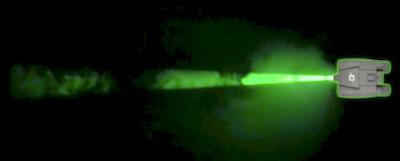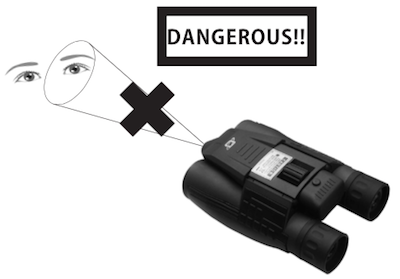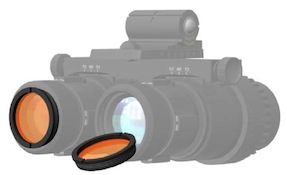Home
A comprehensive resource for safe and responsible laser use
US: Laser-emitting binoculars being sold for "night vision"
The Cassini K-9 “Day and Night Vision Binoculars” are normal magnifying binoculars (for day vision) with a green laser light added between the lenses to illuminate objects for “night vision.” Holding down a button activates a 532 nanometer laser, said to be less than 5 milliwatts, with a spot diameter of 4 meters at a distance of 50 meters.

Looking through standard night vision devices, the user typically sees a green glow from the image intensifier that allows enhanced vision in the dark, without any visible light being added to the scene. In contrast, the Cassini K-9 emits very visible green laser light, simulating the look of a night vision device without requiring any other change to the binoculars.
The product manual warns “Please note the green laser is a device and can be harmful if used improperly, and laser radiation can be harmful to the eyes. Do not look directly into the laser beam output aperture during operation. Laser light when reflected off a mirror like surface can cause serious damage and injury. Since the Laser binocular is not a toy, please keep out of reach of children.”
The manual also includes this cautionary graphic:

Representative prices range from $94 (Amazon) to $160 (Sharper Image). At Amazon, the product has 3.5 out of 5 stars from 13 reviewers. Amazon reviewer comments include:
- “Didn't realize it would have the bright beam of green light...Very grainy, hard to make thing out….”
- “If you are looking for something to view the dark, without being detected, this is not the one. The green laser is visible!! That's, like you can see it in the dark! The range is not up to par. The beam is cone shaped and is approximately 2 feet wide at 7 yards, carry that out to 100 yards, my scope works better at night with my mag-light.”
- “Much better than reviews indicated. Not for tactical use but adequate for bird watching or varmint spotting.”
From Amazon.com and Sharper Image
US: Lasers used to tag UFOs?
Rose refers to YouTube clips where handheld lasers are pointed at moving dots of light in the sky.
Click to read more...
Israel: Advanced anti-laser filter announced
It is not clear whether the filter is available at this time (May 2012). The company intends to incorporate it into glasses and night-vision goggles worn by pilots, to protect against flash blindness, meaning power densities from 100 µW/cm² up to 1000 µW/cm².
From Optics.org
US: Tampa police purchase anti-laser filters for night vision goggles
A person wearing NVGs is normally not at risk of retinal injuries, since direct laser light falls on the image intensifier device and not the eyes. (Depending on the NVG mounting style, it may be possible for direct laser light to enter from the side or from parts of the vision not covered by the NVG optics.) However, a serious concern is with laser light causing “blooming” of the night vision enhanced image, or even damaging the NVG sensor. To help prevent this, Night Flight Concepts developed “Laser Armor” Light Interference Filters.

Company consultant Dr. Dudley Crosson says the screw-in filters “allow the goggles to function normally by reducing the blooming effect significantly.” A Laser Armor product sheet says the filters reduce blue (445-450 nm) intensity by 97%, and reduce green (532 nm) intensity by 99.5%.
From Aviation Today and a Night Flight Concepts press release